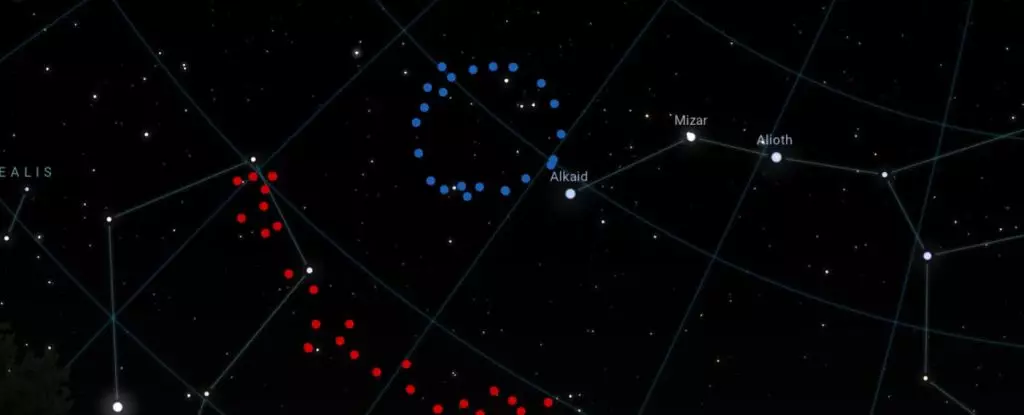The cosmos holds secrets that continuously challenge our understanding of the universe, and the recent discovery of an extraordinary structure dubbed the “Big Ring” is one such enigma. Spanning an incredible 1.3 billion light-years in diameter, this nearly perfect ring of galaxies has provoked deep questions about the current models of cosmology and our perception of the universe’s evolution. Astronomer Alexia Lopez, along with her team from the University of Central Lancashire, has played a pivotal role in this groundbreaking discovery, which could necessitate a reevaluation of existing theories surrounding cosmic formation and distribution.
The Big Ring was unveiled at the 243rd meeting of the American Astronomical Society and has since been documented in the Journal of Cosmology and Astroparticle Physics. This remarkable finding continues to draw parallels with a previous discovery known as the Giant Arc, also identified by Lopez and her colleagues in 2021. Both structures reside in the same celestial neighborhood and share similar galactic distances, collectively unraveling a cosmic puzzle that challenges prevailing understanding. Lopez succinctly summarizes the predicament: “Neither of these two ultra-large structures is easy to explain in our current understanding of the universe.”
This raises salient questions regarding the uniformity of the cosmos as established by the Cosmological Principle. Traditionally, it is believed that matter is evenly distributed across vast scales. Lopez’s statement reflects a growing incredulity towards the standard model that attempts to account for galactic arrangements. If massive structures like the Big Ring and the Giant Arc exist, the implication is profound — our model must adapt to encompass these anomalies.
At the heart of this discussion lies the concept of Baryon Acoustic Oscillation (BAO), which pertains to circular formations found throughout the cosmos. BAOs represent remnants of acoustic waves from the early universe, imprinting themselves onto the density of matter. They typically manifest as spherical formations, uniformly fitting within a diameter of approximately 1 billion light-years. However, the Big Ring defies this classification; instead of conforming to BAO characteristics, it exhibits a corkscrew-like structure, further complicating its classification within existing frameworks.
This divergence provokes profound uncertainty regarding its nature and reinforces the need for innovative discussions and hypotheses. If BAOs are fundamental to our understanding of cosmic structures, the Big Ring presents an anomaly that questions the very essence of this concept. The implications suggest that we might need a new framework altogether to appreciate the complexities and irregularities of the universe.
Researchers are now confronting the challenge of what the Big Ring and its counterpart, the Giant Arc, truly represent. One intriguing possibility is that these massive structures are expressions of cosmic strings — defects in space-time formed in the nascent universe. This hypothesis posits that cosmic strings might resemble protons stretched across the fabric of spacetime, capturing wrinkles created during the universe’s formative moments. Although convincing theoretical grounds exist for cosmic strings, empirical evidence remains scant.
Additionally, alternative cosmological models, such as Roger Penrose’s concept of conformal cyclic cosmology, suggest scenarios where recurring cycles of expansion imitate ring-like structures. However, this notion also suffers from its own complications and has not achieved universal acceptance among cosmologists.
In light of these hypotheses, many scientists find themselves searching for patterns that transcend randomness. Could the Big Ring and the Giant Arc be merely a coincidence in cosmic distribution, or do they hint at a grander arrangement underlying the universe’s apparent randomness? The likelihood of them being ordinary galaxy distributions seems minimal, lending credence to the notion that they might reveal fundamental truths about the cosmos.
The Big Ring serves as a clarion call for astronomers and cosmologists to deepen their inquiry into the structure and evolution of the universe. If established cosmological theories cannot adequately explain the existence of such remarkable formations, it is time for the scientific community to innovate and explore new paradigms.
As our understanding of the universe continues to evolve, questions surrounding the nature of these grand structures challenge our collective consciousness. Space remains one of the final frontiers, and addressing these challenges not only fuels scientific progress but also inspires humanity to seek answers to the most profound questions about existence. Indeed, the Big Ring is not merely a celestial discovery; it is the beginning of a fresh chapter in our quest to unravel the cosmos’s many mysteries.

